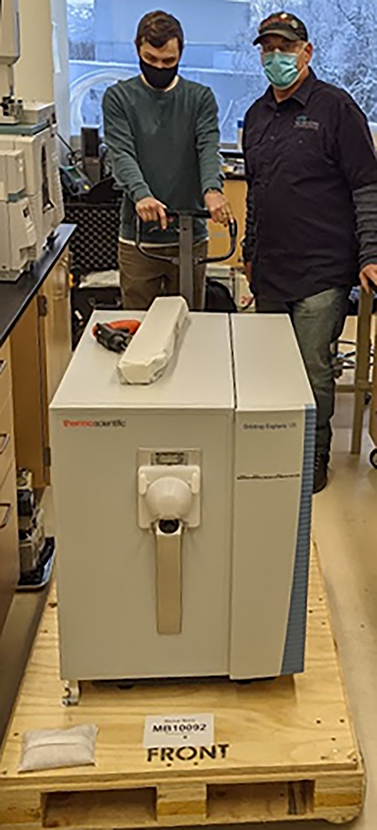A New Asset for ASET
UA researchers will be better-equipped to study everything from oil spills to ground squirrels thanks to funding from the national NSF EPSCoR program.

NSF EPSCoR kicked in $180,000 of the $450,000 price of an Obitrap mass spectrometer, which was installed in February at the UAA Applied Science Engineering and Technology (ASET) laboratory and which is the first high-resolution spectrometer in the state. The funding was part of an NSF Major Research Instrumentation award to UAA Assistant Professor of Chemistry Patrick Tomco, who has also enjoyed national EPSCoR support in the form of a 2019 Track-4 award to conduct oil spill research in Louisiana and Florida.
Mass spectrometry is a key analytical method used to identify and characterize small quantities of chemical species in complex samples. Tomco and his Co-PI’s have already lined up a broad array of planned uses for the device, including studying insecticides, oil spill damage mitigation, plant-herbivore dynamics, medicinal properties of Alaskan botanicals, and the microbiomes of hibernating Arctic ground squirrels. A dozen researchers across the UA system have current plans to use the device, and there’s also involvement outside the university: The Alaska Department of Fish and Game Division of Sport Fish will use it to study a fish pesticide used on invasive Pike, and the Alaska state crime lab plans student internships aimed at developing new forensic toxicology screening methods.
The EPSCoR support came about through a mechanism known as “co-funding,” through which the national NSF EPSCoR organization provides funds to other NSF departments so they can help support worthy research projects located in EPSCoR jurisdictions. As of February 2021 EPSCoR was co-funding six awards in Alaska for a total of about $700,000:
- $202,374 for MRI: Acquisition of a Next Generation Noble Gas Multi-collector Mass Spectrometer System to Support Fundamental and Applied Geochronology Research and Education. Principal Investigator Jeff Benowitz, UAF.
- $33,170 for Alaska Undergraduate Research Experience: Partnering for Alaska Students by Growing Recruitment and Retention through Undergraduate Research. Principal Investigator Rachael Hannah, UAA.
- $29,923 for CAREER: Building research and decision making capacity in the Arctic through deciphering storm-induced sediment dynamics and synergistic Alaska Native coastal science education. Principal Investigator Christopher Maio, UAF.
- $75,000 for Collaborative Research: Origins and population history of marine and terrestrial hunter-gatherer groups. Principal Investigator Nicole Misarti, UAF.
- $175,583 for Collaborative Research: Three-Dimensional Stability of Kinetic Flux Rope Structures in a Collisionless Magnetized Plasma. Principal Investigator Chung-Sang Ng, UAF.
- $180,000 for MRI: Acquisition of a Hybrid Quadrupole Orbitrap LC/MS System to Facilitate Trace Quantitation and Complex Mixture Analyses at the University of Alaska Anchorage. Principal Investigator Patrick Tomco, UAA.

